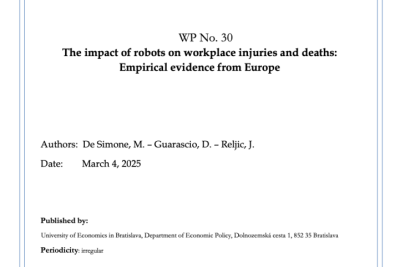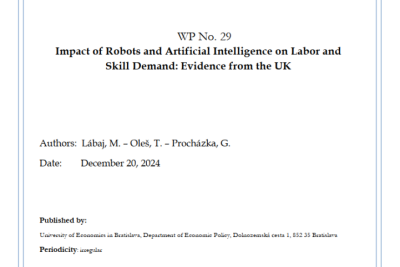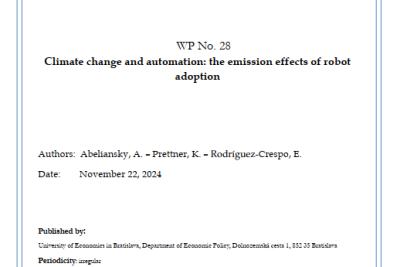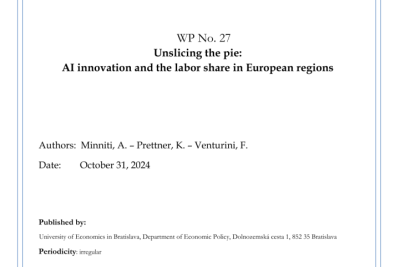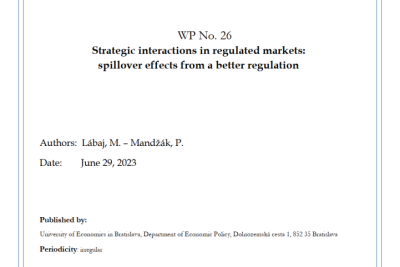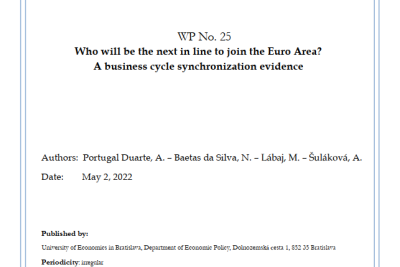Spolu s o.z. SOLIM vydáva Katedra hospodárksej politiky EAPG Working Paper Series. EAPG - Economic Analysis and Policy Group - sú neformálne stretnutia učiteľov, mladých výskumných pracovníkov, študentov a ľudí z praxe, na ktorých sa diskutujú rôzne témy zo spoločenského života, ako aj výskumné práce z rôznych vedeckých oblastí. Okrem stretnutí sme sa pred pár rokmi rozhodli vydávať spolu príspevky, v ktorých by boli prezentované výsledky vlastného výskumu učiteľov a PhD. študentov. Okrem toho majú v rámci EAPG Working Paper Series možnosť publikovať výsledky výskumu vynikajúci študenti inžinierskeho štúdia.
Názov série je: EAPG Working Paper Series
Periodicita: nepravidelne
ISSN 1338-2632
Doteraz publikované dokumenty zoradené od tých najnovších nájdete nižšie:
Číslo 12
Some notes on international transport margins in a balanced World Input-Output Tables
Lábaj, M.
Číslo 11
Optimálne pokuty za kartelové dohody: prípad Slovenska
Kališ, R. - Lábaj, M. - Zemanovičová, D.
Číslo 10
Efektívnosť regulácie v podmienkach slovenského plynárenstva
Silanič, P. - Šiškovičová, A.
Číslo 9
Technologické toky v ekonomicke Slovenska
Kubala, J.
Číslo 8
Hodnotenie eko-efektívnosti pomocou DEA modelov - dvojkroková metóda
Silanič, P.
Číslo 7
Ex-post skúmanie poklesov zametnanosti: Prípad Slovenskej a Českej republiky
Dujava, D.
Číslo 6
Štruktúrna dekompozícia emisií CO2 v Slovenskej republike
Habrman, M.
Číslo 5
Porovnanie ekonomické vývoja v SR s Rakúskom
Svoreňová, M. - Lábaj, M.
Číslo 4
Analýza zdrojov rastu a úrovne TFP v krajinách V4 a vo Fínsku
Kúšik, R. - Lábaj, M.
Číslo 3
Analýza vzťahu ekonomického rastu a nezamestnanosti
Slušná, Ľ.
Číslo 2
Postavenie dolára v medzinárodnom finančnom systéme - vybrané aspekty
Vojtková, M.
Číslo 1
Nekoklasický a keynesovský pohľad na rast ekonomiky
Dujava, D.
- Hits: 58458
Crespo-Cuaresma Jesús, univ. prof. Dr., Vienna University of Economics and Business
Weiss Christoph R., univ. prof. Dr., Vienna University of Economics and Business
Biliana Yontcheva, PhD., Vienna University of Economics and Business
Halická Margaréta, doc. RNDr., CSc., Univerzita Komenského v Bratislave
Zdeněk Tomeš, prof. Ing., Ph.D., Masarykova univerzita v Brne
Martin Kvizda,Doc. Ing., Ph.D., Masarykova univerzita v Brne
Kliková Christiana, prof. Ing., CSc., TU Ostrava
Habrman Michal, Ing., PhD., Inštitút finančnej politiky - MF SR
Kubala Jozef, Ing., PhD., Inštitút finančnej politiky – MF SR
Baláž Vladimír, doc. Ing., PhD. DrSc., CSPV, Prognostický ústav SAV
Sabo Štefan, Ing., PhD., Centrum spoloč. a psychologických vied SAV
Workie Menbere Tiruneh, prof. Dr. Ing., PhD., Ekonomický ústav SAV
Silanič Peter, Ing., Mgr., PhD., Súkromný sektor
Šuster, Martin, Mgr., PhD., Národná Banka Slovenska
- Hits: 63524
- Hits: 51641
We are a group of pedagogues and researchers who are curious about current economic, social, and societal issues and challenges.
- The well-being of our society plays a significant role in our research activities. We try to share our passion about economics with our students.
- Cutting-edge results and methods of the national as well as the international are implemented in our teaching.
- We provide our students with subjects which broaden and deepen their economic knowledge, improve their empirical, statistical, and data processing skills. This furnishes them with a comparative advantage, which enables them to find a job in the labor market.
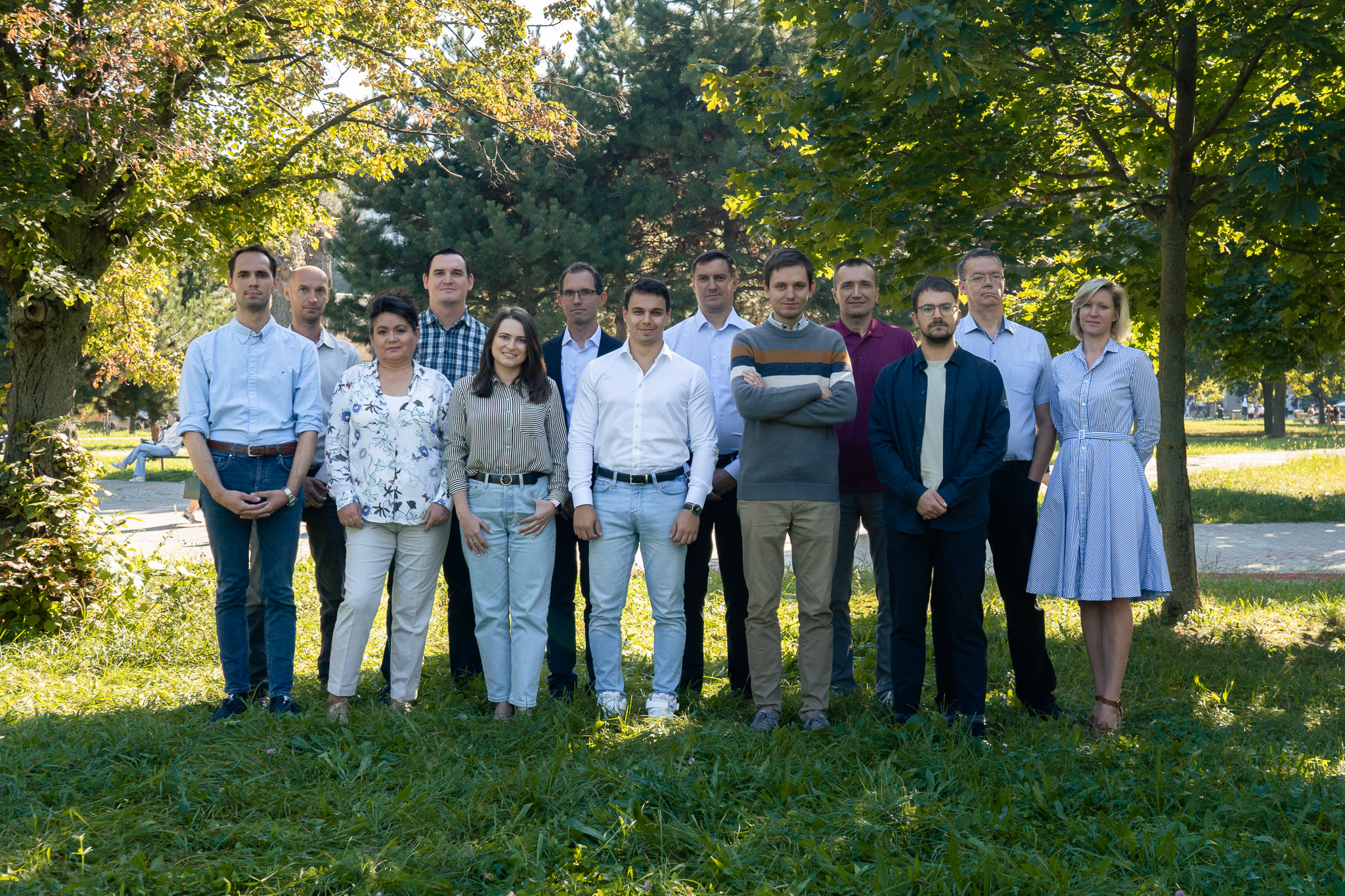
Where you can find us: 4th floor, block B (old building)
Phone: +421 2 6729 1440
- Hits: 96009
Najnovšie metódy pre rozhodnutia a politiky založené na údajoch - jasne a zrozumiteľne
Osvojíte si vedomosti o moderných metódach výskumného dizajnu pre odhad kauzálnych efektov opatrení, programov a politík.
Získate pokročilé zručnosti pre používanie moderných softvérov (napr. Stata) v empirickom ekonomickom výskume, naučíte sa skripty, programovať pokročilejšie analýzy.
Naučíte sa formulovať ekonomický problém a navrhnúť výskumný dizajn pre jeho preskúmanie prostredníctvom empirickej analýzy, formulovať hypotézy a analyticky ich potvrdiť alebo vyvrátiť.
Vyučujúci:
Martin Lábaj, Erika Majzlíková
Predpoklady: aspoň jeden semester ekonometrie
Zaradenie v študijných programoch: povinný predmet št. programu Aplikovaná ekonómia (2.st), výberový predmet št. programu Ekonómia (3.st)
Stručná osnova:
- Základné pojmy, napr. kauzalita, skreslenie, ceteris paribus.
- Výskumný dizajn, indentifikačné stratégie, estimátor.
- Znáhodnené kontrolované experimenty.
- Regresia s viacerými kontrolnými premennými.
- Skreslenie spôsobené vynechaním premennej.
- Inštrumentálne premenné.
- IV estimátor a dvojstupňová metóda najmenších štvorcov.
- Regresia diskontinuitných zmien.
- Diff-in-Diff estimátor.
- Odhady na spojených prierezových údajoch a panelových údajoch pre hodnotenie efektov politík.
- Metóda syntetických kontrolných skupín.
- Neštandardné štandardné chyby
Odporúčaná literatúra:
Cunningham, S., 2021. Causal inference: The mixtape. Yale University Press.
Angrist, J.D. and Pischke, J.S., 2014. Mastering'metrics: The path from cause to effect. Princeton University Press.
Wooldridge, J.M., 2016. Introductory econometrics: A modern approach. Nelson Education.
Angrist, J.D. and Pischke, J.S., 2008. Mostly harmless econometrics: An empiricist's companion. Princeton university press.
- Hits: 1900
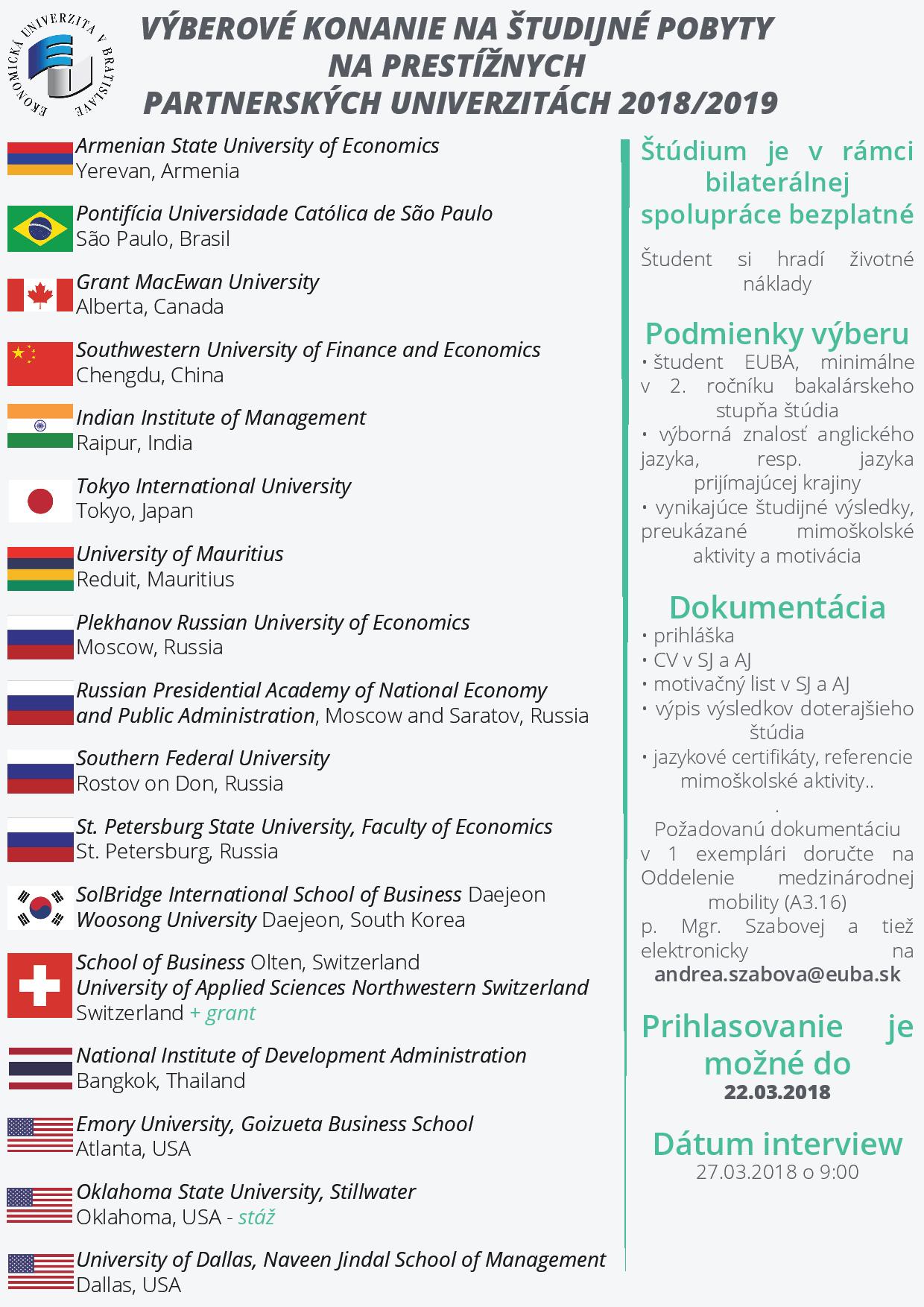
- Hits: 7548
Abstract
This paper examines the impact of robotisation on workplace safety in EU manufacturing sectors between 2011 and 2019. To address endogeneity concerns, we employ an instrumental variable approach and find that robot adoption reduces both injuries and fatalities. Specifically, a 10% increase in robot adoption is associated with a 0.066% reduction in fatalities and a 1.96% decrease in injuries. Our findings highlight the context-dependent nature of these effects. The safety benefits of robotisation materialise only in high-tech sectors and in countries where industrial relations provide strong worker protections. In contrast, in traditional industries and countries with weaker institutional frameworks, these benefits remain largely unrealised. The results are robust to several sensitivity tests.
- Hits: 63
Abstract
Over the past four decades, automation technologies have replaced routine tasks performed by medium-skilled workers, and contributed to increased labor market polarization. With the advent of artificial intelligence, this dynamic may have shifted, extending task substitution to non-routine tasks performed by high-skilled workers. Using textual analysis and descriptions of technology found in patent texts, we construct novel occupational exposures to robot and artificial intelligence technologies. These occupational exposures are then used to analyze changes in labor and skill demand over the last decade in the United Kingdom. We find that the middle part of the income distribution is primarily exposed to robot technology, while exposure to artificial intelligence increases monotonically across income percentiles. Second, we find that exposure to robots is strongest among high school dropouts and declines monotonically with education, while artificial intelligence automation has a limited impact on the same workers, with a pronounced exposure among college graduates. Third, our findings suggest asymmetric effects of automation technologies across skill groups. Robot automation reduces demand for low-skilled workers, while AI technology shifts demand away from high-skilled workers, with the direct effects consistently negative despite the presence of several compensating mechanisms. Finally, a joint estimation of the effects of robot and AI automation shows that robot automation is positively associated with an increase in demand for skilled workers, while AI automation is weakly associated with a decrease in demand for skilled workers. These patterns indicate structural changes in the labor market, with important implications for wage inequality and the future of work.
- Hits: 293
Abstract
What are the environmental impacts of the increasing use of automation technologies? To answer this question, we propose a model of production in the age of automation that incorporates emission externalities. We derive a threshold condition subject to which the use of industrial robots affects emissions. This model leads to three testable predictions, i) the use of industrial robots causes higher emissions on average, ii) with increasing efficiency of industrial robots, the effect becomes weaker and could turn negative, and iii) in countries in which electricity is predominantly produced using (clean) renewable energy, industrial robot use has the potential of decreasing emissions. Empirically, we find support for the theoretical hypotheses implying that the effect of automation on emissions is non-linear or moderated by other variables.
- Hits: 81
Abstract
We study how the development of Artificial Intelligence (AI) influences the distribution of income between capital and labor and how this, in turn, exacerbates geographic income inequality. To investigate this issue, we first build a theoretical framework and then analyze data from European regions dating back to 2000. We find that for every doubling of regional AI innovation, there is a 0.7% to 1.6% decline in the labor share, which may have decreased by between 0.20 and 0.46 percentage points from a mean of 52% due solely to AI. This new technology is particularly detrimental to high-skill and medium-skill labor. The impact on income distribution is driven by worsening wage and employment conditions for high-skill labor, and by wage compression for medium- and low-skill labor. The effect of AI is not driven by other factors affecting regional development in Europe, nor by the concentration process in the AI market.
- Hits: 143
Abstract
Usually, health policy makers face a trade-off between benefits and costs from healthcare markets regulation and deregulation. We argue that these markets and policy reforms should not be studied in isolation as the effects from regulation in one market spillover to other markets. In particular, we study entry decisions and strategic interactions between general practitioners, pediatricians, and pharmacies. We show that a better regulation and accessibility of one profession allow policy makers to relax spatial restrictions and regulations of other healthcare professionals. We document that these spillover effects could be sizeable as the entry thresholds for pharmacies to enter the market decrease by 70 % with the presence of a general practitioner. Our counterfactual analysis suggests that a better coverage of GPs would improve spatial accessibility of pharmaceutical services and lead to an entry of new pharmacies in currently unattractive markets, mostly in rural areas.
- Hits: 116
Abstract
The aim of this paper is to investigate business cycle synchronization between seven candidate countries to the Euro Area (EA) – Bulgaria, Czech Republic, Croatia, Hungary, Poland, Romania and Sweden – and the Euro Area (EA-12/EA-19), France and Germany. The Hodrick-Prescott filter is used to decompose the real Gross Domestic Product into trend and cyclical components for the period 1995Q1-2019Q4. The results point to the existence of a strong business cycle synchronization between Sweden and the Euro Area, Germany, and France. The second highest correlation was observed for the Czech Republic followed by Hungary, Poland and Croatia. In contrast, Bulgaria and Romania show the weakest business cycle synchronization with both the Euro Area and the core economies. We conclude that Sweden is the most prepared country to be the next passenger in the single currency train from the perspective of business cycle synchronization.
- Hits: 125
Strategic partner
Main Partners
Partners




